A Personal History of Making Things
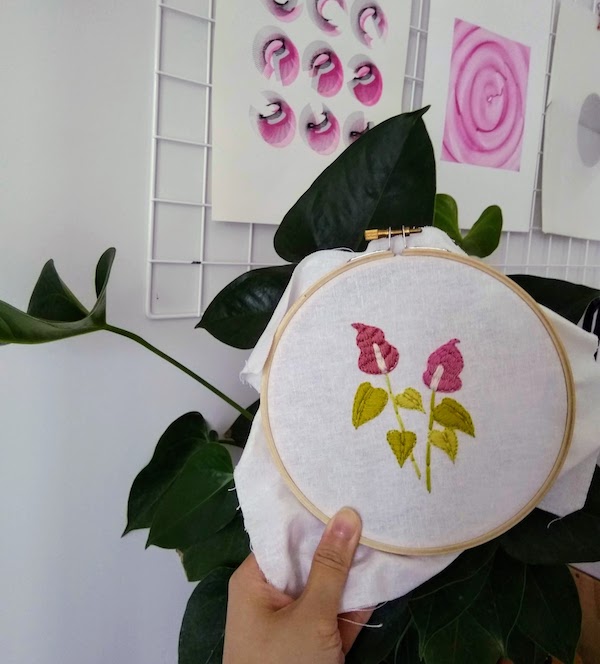
Pink anthuriums. An experiment in embroidery.
Part I
After being a software engineer for so long, there’s a certain satisfaction in making physical things that I have missed.
The thing about digital work is that it is so… intangible. But not only that, to enjoy the work, you have to experience it via the medium of a computer. Without a computer, my work lies dormant, meaningless without an audience. It cannot be touched nor held. It can, however, evoke tactility and sensations. I think of moire patterns and the strange thing it does to my brain when lines and dots move in ways that you don’t expect them to.
#inktober2019 day 24: dizzy.
— piratefsh (@piratefsh) October 25, 2019
today's prompt was begging for some moire patterns. last one is my favorite. pic.twitter.com/Ej7nbrjqhg
My fascination with drawing machines (like plotters) lies in their ability to translate a piece of digital work into its physical, albeit still two-dimensional version. The satisfaction of seeing SVGs as lines of ink on paper was immense. And yet, it was still not enough. It still remains a pretty thing to hang on my wall.
I’m a software engineer, computer programmer, web developer, whatever you want to call it. But before I made the computer the tool of my profession, I used to make things with my hands.
Part II
I learned how to sew by hand from my mom. I don’t remember how old I was, but I remember being very young and very proud about it. And when I got tired, she taught me how to use a sewing machine, the same machine that my mom received from her mother as a wedding gift. The same sewing machine that still sits in her craft room today, more than 30 years later.
I made angel dolls, stuffed with cotton balls, hair made out itchy polyester yarn. I sewed them eyes of seed beads and embroidered smiles. I made four, and gave them each to the aunts in my family for Christmas. One of my aunts later told me that the others thought they made for strange gifts, but she still kept the one I made for her.
With every year, I learned a new skill. I must have been around eleven or twelve when my mom taught me how to knit. Everything I learned how to craft came from her. I used to joke that I was raised to be a good housewife, but I don’t think that’s a fair thing to say. I was raised to learn skills so I could do things for myself.
Knitting is an absolutely irrelevant skill to have for a child living in the tropics of Southeast Asia. I made a scarf, purple with alternating stripes of knit and purl. The edges would curl and I didn’t understand why – I probably didn’t get the tension right. I loved it anyway and trotted around the house wearing this itchy scarf in our too-humid too-tropical hometown. But I couldn’t put it down because I loved it so much.
I crocheted little purses for my relatives out of itchy polyester yarn, finished with spare buttons harvested from my mothers’ sewing drawer. I bought half-metres of ribbons (the minimum length of sale) from the only craft supply store in my hometown, a place that was nothing short of heaven for the aspiring seamstress in me. I loved lace the most, hoarding them because I thought they were too pretty to use.
One year, I spent a fraction of my allowance buying small squares of felt to make little charms shaped like food. I sold them at a local comic convention for a few ringgit each and never felt so satisfied when people bought them to adorn their phones and bagpacks.
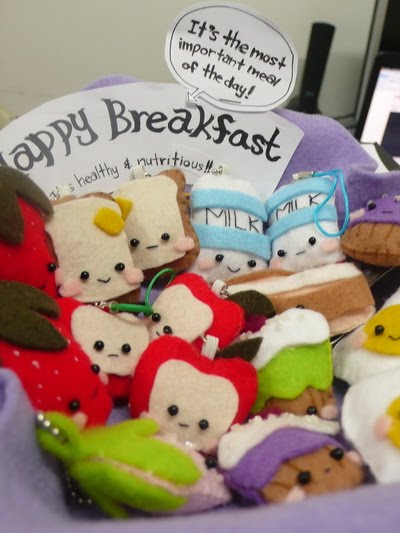
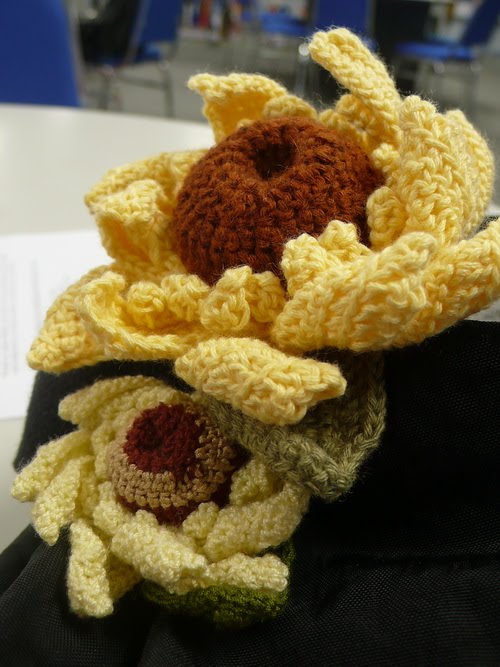
Left: My contribution to a table at a comic convention that my friends and I shared in 2009.
Right: Crocheted sunflowers.
My best friend in secondary school cosplayed as one of my favorite anime characters. The character had a sidekick that was a small white dragon that sat on his shoulder. I made her a stuffed dragon, using an old wire hanger as armature, knotting rows of string for its mane.
I gave up on knitting and decided that crochet was my craft of choice. I learned amigurumi and made little creatures with beaded eyes. I was in love with someone who loved sunflowers, golden and large. I learned how to make crocheted sunflowers from a free tutorial online, turning them into pins I wore on my messenger bag throughout college. I thought it would somehow bring us closer.
My feelings were not reciprocated alas, but I kept on making them anyway – in various sizes, the smallest the size of an Oreo and the largest the size of my palm. I mailed a large one to the aunt who kept my weird stuffed doll.
Part III
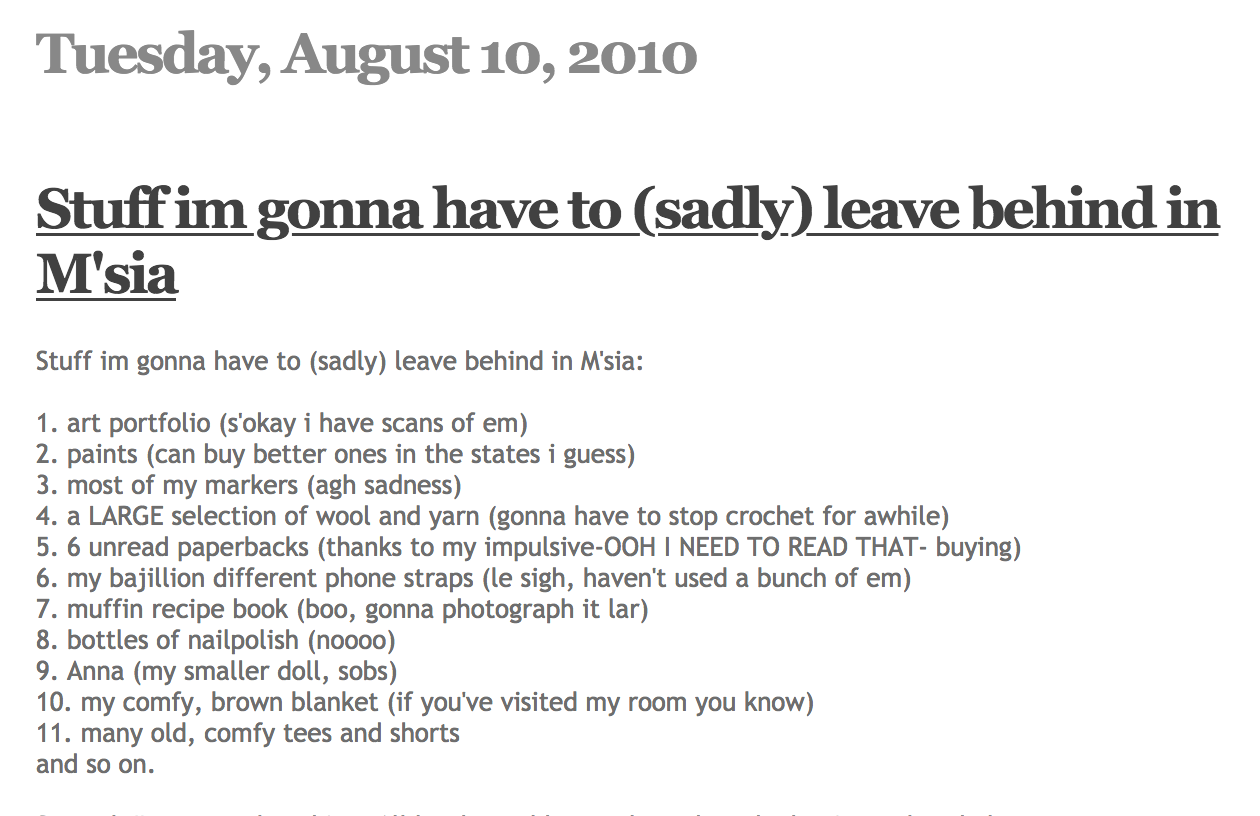
A list of things I had to leave behind when I moved for school. From the archives of my Blogger blog. I was very distraught about leaving behind all my art supplies.
Along the way I moved to Wisconsin for school, leaving behind my fabric treasures. At 19, I saw snow for the first time in my life, watching its delicate, dusty flakes getting caught in my hair. I started to imagine what it would be like to finally put those knitting skills to use. A chunky scarf perhaps? A pair of mittens?
(A spoiler alert: I never knitted another stitch.)
I ended up majoring in Computer Science, my time steadily filled up with classes, assignments and potluck parties. Crafting became hard to do – my crochet needles were so far away. Instead, I started to spend more time working in the digital world. I designed posters for student groups at an hourly rate, drawing Pokemon with the office tablet when I clocked off.
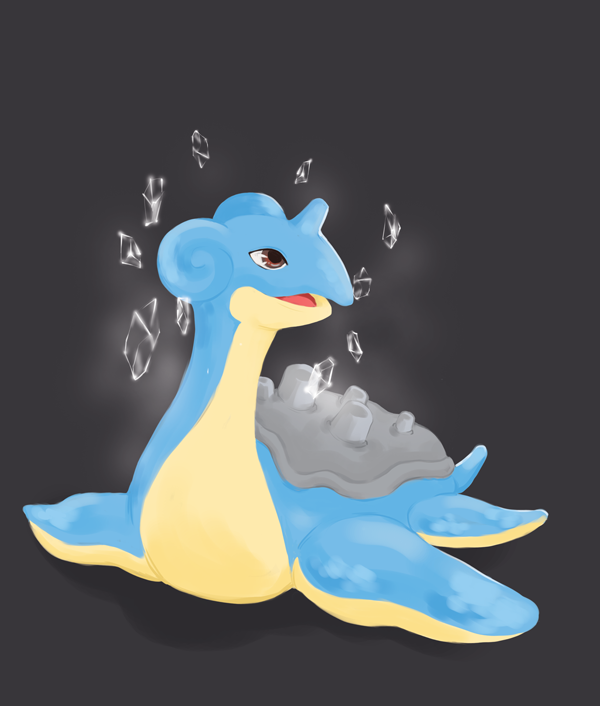
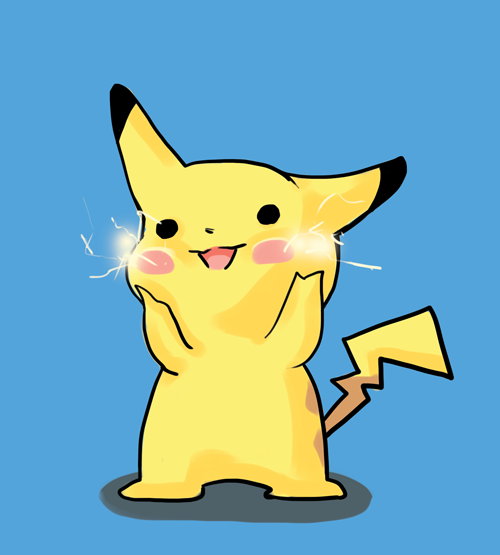
Lapras used Ice Shared! And Pikachu is just being cute.
The further I ventured into the digital world, the less I used my hands. One summer, I took a week-long class on HTML and CSS and graduated from a designer to a webmaster. In retrospect, that transition cemented my future as a software engineer, crafting beautifully designed features out of logic and boxes.
As programming gradually took over my waking hours, it started to change the way I formed ideas. My brain became accustomed to thinking in logical steps, imagining each step executed flawlessly on the machine, deterministic and predictable. The machine always does what it’s told – if your program isn’t behaving, the fault is often yours, not the computers’. And for me, programming became a task of ideas – the weaving of concepts, algorithms, data structures together to birth a series of perfect instructions to be run by a perfect executioner.
Of course, computers are not nearly perfect (case in point, floating point numbers). But they were predictable, and that comfort quickly became my fault.
Here’s what I noticed: I got so used to thinking in discrete steps, a series of instructions to produce an outcome. When I would draw a thing, I imagined in my head a perfect execution of what I wanted it to be. Here’s the thing though, computers are perfect executioners, but my human self was not. It became easy to get frustrated when my hand would falter at simple things like drawing a straight line. Isn’t that the irony, that computers are good at what humans are not and vice versa. Lines and perfect circles are one of the hardest things to draw freehand, trivial tasks for the computer.
It’s easy to get frustrated at the mismatch of an idea in your head and it’s actualization. Or in meme terms, “Expectations vs. Reality”. It took me awhile to divorce myself from the habit of coming to a piece of work with a fully fleshed idea. Instead, it’s much more fun to let myself be driven by the material – to remember what it was like to be the young child who let herself be excited about inches of lace. I have to say, it’s a lot less stressful to let curiosity and experimentation take over the creative process instead of coming to it with a fully formed idea.
my contribution the the craft table at @whitneymuseum 's member night. pic.twitter.com/nyzyIP6zLM
— piratefsh (@piratefsh) December 8, 2019
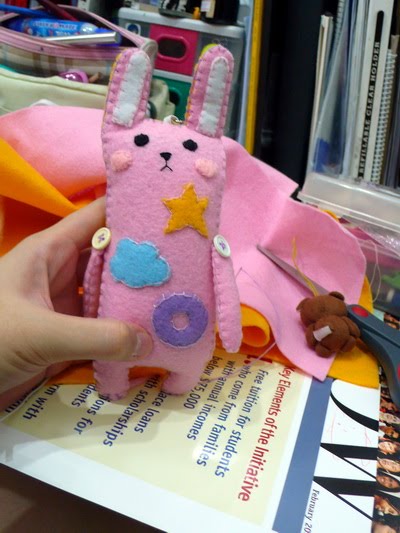
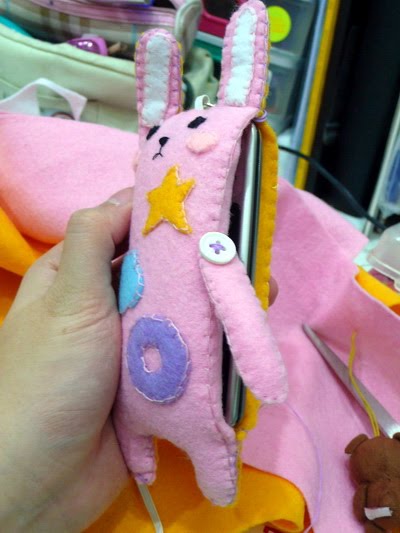
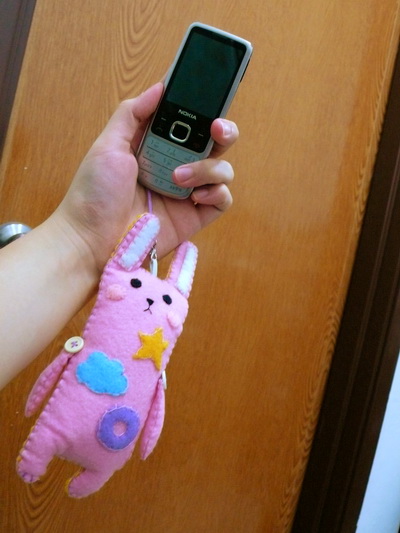
My proudest invention from 2010: a phone charm that doubled as a phone case
Part IV
I’ve recently been reintroduced to the delight of making something I love. I know when I have made something that I am truly excited about because after I am done, I just can’t put it down.
I’ve always loved jewelry and last year I started taking classes to learn how to make them. It’s been very satisfying to make pretty things that you can wear. Or to put it in a pretentious term, “wearable art”.
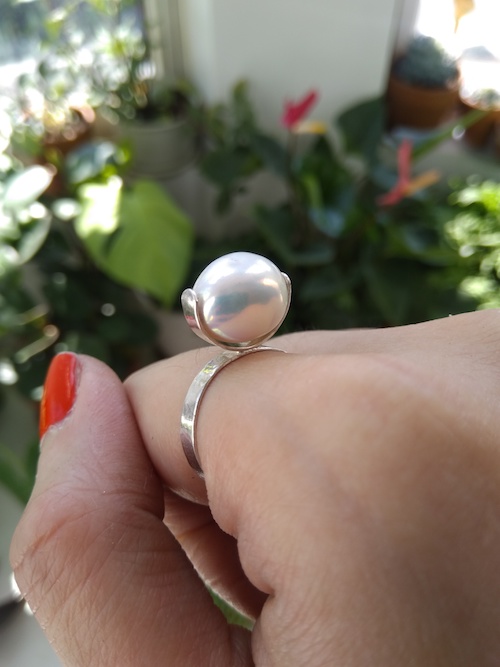
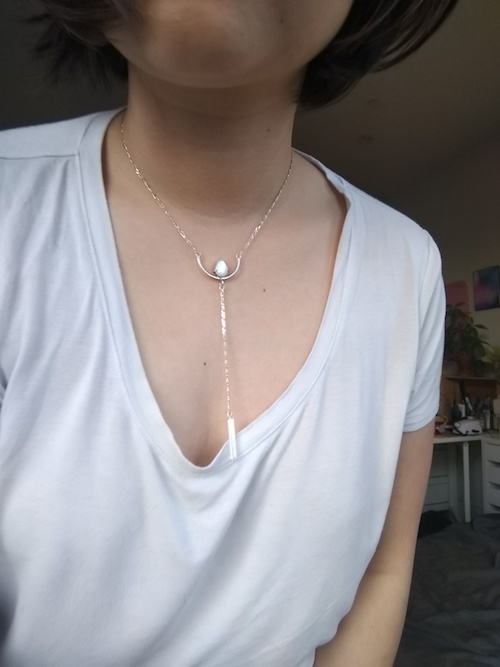
Silver jewelry, hand fabricated and polished.

My home ‘bench’.
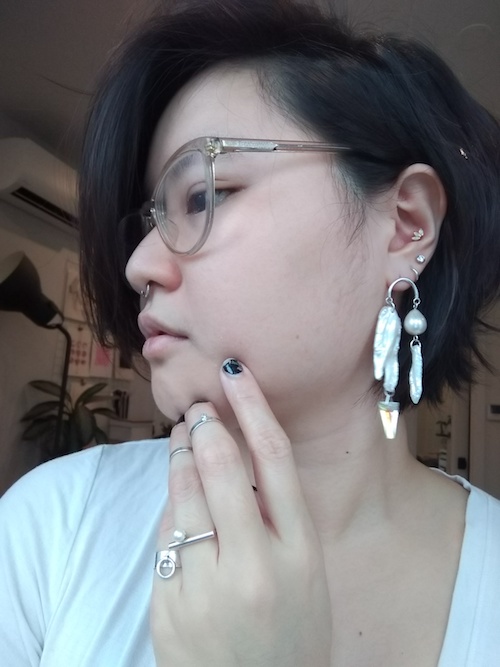
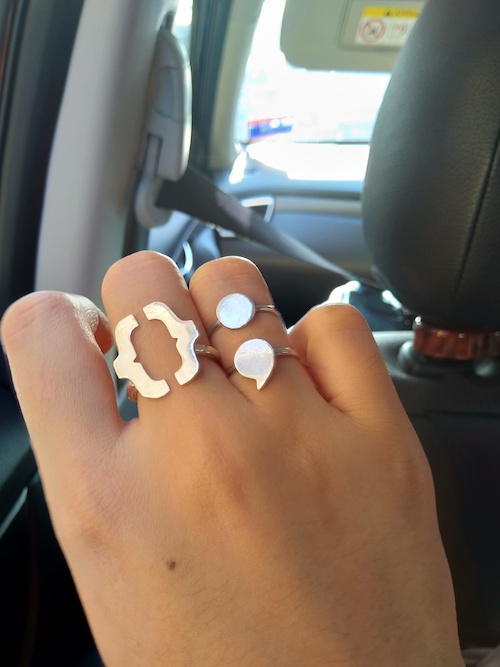
My favorite pieces so far – large dangly pearl earrings and punctuation rings.
It feels good to put something on and not want to take it off because it’s so delightful.
Part V
I have some thoughts about why the experience of making digital art is so different than working in the physical world.
Computers make for very cold material for creative work. It is intangible – perlin noise, space-walking algorithms, random number generators, mathematical concepts, you can’t hold them. It doesn’t have the same tactility as things of this world.
I miss being able to grasp material in my hands, manipulate it, seeing it interact with my body and surroundings. I want to inhabit it, adorn myself with it, to get lost in its sensations. Maybe that’s why I am so in love with metalworking for making jewelry. It is the perfect intersection of aesthetics and wearability that drives me crazy.
Digital material doesn’t do the same for me and I keep on wondering why. What even is digital material? When I think about the things I play with when making generative art, I think of the toolbox of techniques that I have at my disposal. I can make grids, create flow fields, employ cellular automata, randomness and so on. It still remains true that digital work can only inhabit the sense of sight and sound, and maybe thats not enough. The sense of touch, smell and taste are left barren, untouched, unstimulated. In my early 20s as programming became a part of my identity, I filled them with tea, perfume and sex, easy and hedonistic ways to lose myself in the senses.
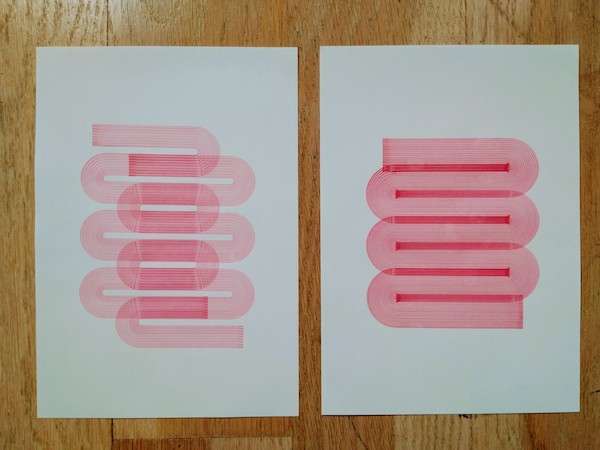
Plotter work from Inktober 2019.
What joy is there in making something beautiful to only store it in a folder of SVGs on your Desktop? I want nothing more than to interact with my art, to inhabit the same space that it does.
Would I maybe feel differently about my work if I projected it in a gallery room? Or in a VR chamber? What if I also added scent to the ventilation and had tiny robots tickle you? How much immersion is enough to make me forget that what I am experiencing lies behind a metal box? What if I could wear my generative art? I think about the work done by Sylvia Heisel who 3D-prints fabric for fashion. Would that change the way I feel about programming as a creative tool?
Perhaps I haven’t been doing myself a favour by restricting myself to the digital screen. There is a whole world of electronics out there.
I attended a School for Poetic Computation (SFPC) student showcase once. SFPC, for the unfamiliar, is a well-known program where you can do to learn how to make art informed by computing. My favorite exhibits were not very technically complex. One was a gachapon dispenser that required two people to operate and to share it’s contents. Another was a booth where you could ‘sell’ your personal data in exchange for another persons’. Then there was a secret room where you can only enter once you have given up your phone. It was a good reminder that technology is only a means to an end. I liked the SFPC motto of ‘more art, less demos’, where demos refer to demonstrations of technical complexity.
Epilogue
Anyway, these are my thoughts. I tried my best to put them down in words with the hope of providing a personal perspective. Have you felt similar things? Do write to me about them at sherminn [at] piratefsh [dot] net. I’m no longer on most social media but I read all my emails.
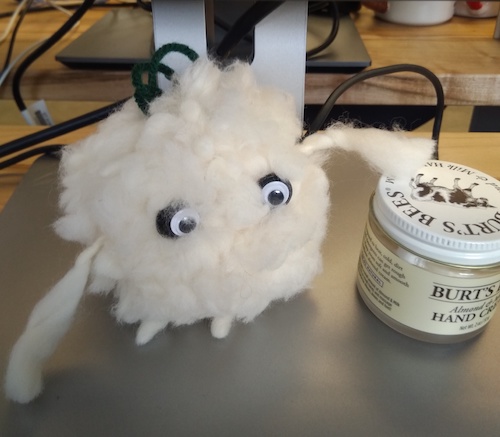
A fluffy pom pom ball with eyes, the first yarn thing I’ve made in awhile.
With love,
Sher Minn
Many thanks to my friend Seng Ming for valuable feedback on earlier drafts of this essay.